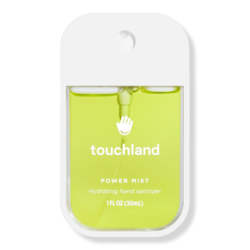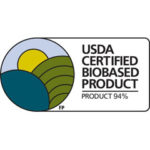The word on everyone’s lips during the pandemic, after “Shit!” was another S-word: sanitizer. With sales of the hand cleansers skyrocketing 600 percent in 2020—and Purell alone raking in $1.5 billion from 2020 to 2021—you (ironically) couldn’t get your hands on the stuff, snatching up whatever you could find.
Now that shelves are booming with more brands and forms than ever, we wanted to know: Which is best, and why? Must they smell so strong? Are the superbugs finally gonna get me? Here, we dive into the science of sanitizers to answer all the (metaphorical) burning (not ouch-this-sanitizer-is-burning) Qs.
Do I Need to Worry About Superbugs Anymore?
Along with chain necklaces and grunge plaid, there was another ‘90s staple called tricolsan, the active ingredient in most antibacterial gels and washes. This guy was indeed the most popular kid on the sanitizing block, but like those other New Kids, he was replaced—in this case, by safer antimicrobials.
In 2016, the FDA banned the use of triclosan in over-the-counter hand and body washes after studies suggested that widespread and long-term use of the chemical could result in bacteria resistance, potentially leading to the rise of germ-defiant superbugs. (Netflix: Your next horror series? An alternate reality where the FDA let triclosan live.)
The other issue with triclosan: It’s tachyphylactic, which means the more you use it, the less effective it eventually becomes, says Jessie Cheung, M.D., a Chicago-based dermatologist. Not a good look for a product meant to thwart sickness-inducing microbes.
With the exit of triclosan came the current sanitizer crop, infused with either alcohol or benzalkonium chloride (BC). Both slaughter microorganisms, but the CDC recommends sanitizers with alcohol.
Microbiologist Charles P. Gerba, Ph.D., a professor of virology at the University of Arizona, has run tests of sanitizing products, including one on a BC wipe. “It is not effective against certain types of viruses, like norovirus,” he says. “Some alcohol hand sanitizers also contain chemical compounds similar to BC to increase their effectiveness.”
Does the Type of Alcohol in a Sanitizer Matter?
Indeed. Ethyl alcohol (also called ethanol) and isopropyl alcohol are safe on skin. But FDA testing has found that some sanitizers contain other alcohol types, including methanol and 1-propanol, which can poison you when rubbed into the skin—and toxic if ingested.
Sometimes, says Dr. Gerba, “hand sanitizers that use ethyl alcohol add a bitter substance to discourage people from ingesting it.” When a product lists “denatured alcohol” on its labels, that indicates it has ethyl alcohol spiked with some foul-smelling, ick-tasting substance. This becomes a problem when that substance is methanol, or other toxic chemicals.
According to a study in Food Science, 5 to 10 percent methanol is the most common additive in denatured alcohol. Nausea, dizziness, weakness, blurred vision, and seizures are signs of methanol poisoning—if you’re experiencing any of these post-sanitizer use, get ye to the ER, state.
Now, if you’re wondering…
- Why doesn’t everyone just use safe-to-drink alcohol in their products? Hello, revenue. Denatured alcohol amounts to around $6 per 750 ml, while drinkable alcohol is on average $15 for the same amount. The denatured variety doesn’t carry the heavy taxes on the kind of alcohol that goes into your jalapeño margarita.
- Who’s gonna drink sanitizer in the first place? Mostly little tikes: Poison Control gets hundreds of monthly calls for accidental ingestion of hand sanitizer, according to the FDA, and most are related to kids 5 and under. (Calls spiked 79 percent in March 2020 vs March 2019 due to sanitizer use during COVID.)
- How can I tell if my sanitizer is safe? The FDA has issued numerous recalls of sanitizers containing methanol or other dangerous substances. To make sure your brand of choice won’t send you to the hospital, the FDA has helpfully put together a most-wanted list for offending sanitizers.
Does the Amount of Alcohol in a Sanitizer Matter?
Is less more, or is more more? In this case, get a little greedy! The CDC advises a sanitizer with at least 60 percent alcohol, but we’ve seen over-the-counter versions go as high as 80 percent. Per a 2022 article published in the medical database StatPearls, sanitizers with 85 percent ethanol were “significantly better at reducing bacterial populations” than those with 60 to 62 percent. (Granted, they were concerned with sanitizer use by healthcare workers who might transmit microorganisms between patients.)
For the average human, 60 to 70 percent should get the job done. “Sixty percent is the minimum to have a significant impact on killing many pathogens, but 70 percent’s performance is better,” says Dr. Gerba.
If your skin is is as parched as a dried banana chip, consider a 60 percent formula to see if it feels gentler. If you don’t have a dryness concern and feel like maxing out, give this cult brand a whirl: Murphy’s Hand Sanitizer Bundle, $10 for 3-pack, at 80 percent alcohol.
Do Sanitizers Have to Be So Drying?
Drink or slather it, alcohol is dehydrating by nature. Happily, cosmetic chemists have had mercy on our skin by infusing sanitizers with moisturizing agents. Look for water-binding glycerin, soothing aloe vera, or conditioning plant extracts, says cosmetic chemist Ginger King.
GOTTA READ: The Best Hand Creams For OCD Overwashers
Dove, creator of the original no-soap moisturizing bar, has recently turned its sights to making another classically drying beauty product (sanitizer) less so, with Dove Nourishing Hand Sanitizer Deep Moisture, $14.99 for 4-pack. Its 61 percent ethyl alcohol blends with a cocktail of hydrators, including glycerin, dimethicone, soybean oil, and the fatty-acid-rich echium plantagineum seed oil.
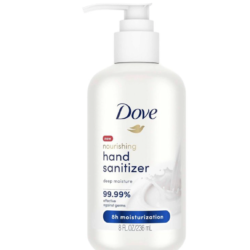
The highly sensitive-skinned may want to skip the alcohol and go with benzalkonium chloride. Though it doesn’t slay all microbes as well as Buffy (or, you know, alcohol), a study published in The Journal of Hospital Infection found it does kill COVID-19 on hands, and researchers called BC’s less-irritating properties an advantage over alcohol. Most BC options look like they belong in a medical facility, but this baby formula is more home-friendly: Babyganics Alcohol-Free Foaming Hand Sanitizer, $20.97 for 3-pack.
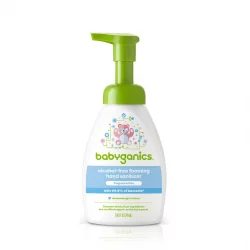
Which Is Better: Gel, Wipe, or Spray?
Take dogs: While your “PUGS BEFORE PEOPLE” gear may deserves a spot in the Met Costume Institute, your friend only endorses terrier tees. Same with sanitizer forms—it’s mostly a matter of personal preference. But there are a few differences worth noting.
- Gels: Dr. Gerba’s preference. The World Health Organization recommends a coin-size amount, which King equates to about three pumps. Don’t go overboard: More goo won’t offer more protection—it’s just going to take longer to rub in, she says. Since everything ’90s is back, we’ll suggest a gel classic: Bath & Body Works Anti-Bacterial Moisturizing Hand Sanitizer, $7.50, with 70 percent alcohol, shea extract and aloe to soften, and the Warm Vanilla Sugar scent every ’90s teen worshipped.

- Sprays: They evaporate quickly, so make sure to rub your hands together right after spritzing. Aerosols deliver a finer mist, so it may be easier to get fuller coverage, which is why we at Mental love ’em. Try Breathe Hand Sanitizer Spray, $4.99, which continually mists out 75 percent alcohol in an environmentally friendly way, using compressed nitrogen.
 Non-aerosols disperse less evenly, so hold the bottle a bit closer to your hands and be sure to douse all areas. One beauty editor favorite, Touchland Power Mist Hydrating Hand Sanitizer in Aloe You, $9, packs 70 percent ethyl alcohol into a little iPhone-esque pump.
Non-aerosols disperse less evenly, so hold the bottle a bit closer to your hands and be sure to douse all areas. One beauty editor favorite, Touchland Power Mist Hydrating Hand Sanitizer in Aloe You, $9, packs 70 percent ethyl alcohol into a little iPhone-esque pump.
- Wipes: Wipes tend to have less alcohol and lots of moisturizers, because otherwise the wipes themselves wouldn’t stay moist, says King. For this reason, wipes can be a good pick for dry skin and may feel less tacky than some gels. EO Hand Sanitizer Wipes in French Lavender, $29.99, has 62 percent ethyl alcohol, glycerin, and aloe. If you want a BP option, Travel-Lite Hand Sanitizing Wipes, $30.88 for 200 individually wrapped towelettes, hydrates with glycerin, while Wet Ones Antibacterial Hand Wipes Fresh Scent, $40.13 for 30-pack, uses dimethicone; both also contain aloe.
What Sanitizer Brand Do I Choose?
Watermelon scents. Luxurious packaging. Cheap vs couture. Does any of it matter?
“Hand sanitizers are considered an over-the-counter drug,” King says, “so the efficiency should be the same in each one you find, as long as it contains the drug fact label.”
If you’re looking for gorgeosity, the minimalistic design of Noshinku Refillable Pocket Sanitizer, $26 for 3-pack, is, as Ferris Bueller would say, so choice. With 70 percent ethyl alcohol, plus aloe and glycerin.
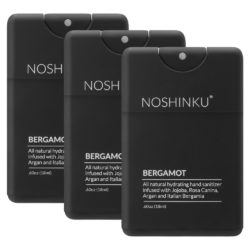
Fragrance, depending on the brand, may jack up the price, but at least your hands can, if you so choose, smell like citrus instead of lab chemicals—and still stay clean. In fact, certain fragrance oils are themselves antiseptic. According to a study in the journal Microbios, the essential oils of lemongrass and orange were the most effective against all bacteria strains and fungi tested; peppermint and eucalyptus oils were a close second.
Be sure to read labels closely, though: Many sanitizers contain lemongrass or orange scents, but not essential oils. A true pick: LL Lemongrass Hand Sanitizer, $4.99 for spary or gel, with 62 percent alcohol. It’s a cutie!
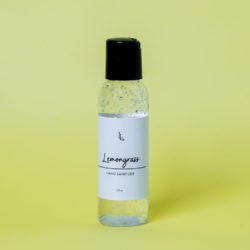
If you’re buying for super youngsters, avoid stuff that smells like food or candy; it stands to reason they’d be more likely to gulp a sweet liquid vs one that reeks. And if you hail from the House of Lizard Skin, you may want to go without fragrance, which can have a drying effect, says King. Look for the words “fragrance free,” as “unscented,” nonsensically, may still have scent.
What’s the Deal With “Natural” Sanitizers?
In theory, “natural” hand sanitizers rely on naturally derived alcohol, free from chemical pesticides and synthetic fertilizers, says King. In order for a sanitizer to be “organic,” she continues, the alcohol and other ingredients must come from a source that hasn’t been genetically modified.
Of course, as with most over-the-counter beauty products, the words “organic” and “natural” are as prolific as weeds in a tomato garden—without the oversight of a gardner. In other words, the FDA does not regulate their usage, so choose a trusted brand and read labels. You can also look for a seal if…
-
 Natural and sustainability are important to you. The USDA Certified Biobased Product seals are part of the USDA BioPreferred program, which, the organization states, “assures a consumer that the product contains a USDA-verified amount of renewable biological ingredients. Biobased products are derived from plants and other renewable agricultural, marine, and forestry materials.” The product will list the percentage of naturally derived ingredients on the label. Honest Hand Sanitizer Spray, $5.97 for 2-pack, has 100 percent naturally derived ingredients, as does Lemyn Organics Medical-Grade Hand Sanitizer Gel, $11.99.
Natural and sustainability are important to you. The USDA Certified Biobased Product seals are part of the USDA BioPreferred program, which, the organization states, “assures a consumer that the product contains a USDA-verified amount of renewable biological ingredients. Biobased products are derived from plants and other renewable agricultural, marine, and forestry materials.” The product will list the percentage of naturally derived ingredients on the label. Honest Hand Sanitizer Spray, $5.97 for 2-pack, has 100 percent naturally derived ingredients, as does Lemyn Organics Medical-Grade Hand Sanitizer Gel, $11.99.
- Organic is your jam. The USDA Certified Organic seal means the product boasts at least 85 percent organic ingredients. Try Dr. Bronner’s Peppermint Organic Sanitizer, $4.24, or Intelligent I-N One-Body Sanitizer, $15, with 68 percent alcohol, glycerin, and peppermint oil.

One note of caution: If you tend to have skin reactions to new products, you may want to avoid natural sanitizers. “The problem with [things like] plant essential oils,” says Dr. Gerba, “is that people are more likely to become sensitized to them or may have allergies.”
Am I Using This Thing Correctly?
So by now you know that hand sanitizers work in essentially the same way—but that’s only true if you’re rubbing the right way. A quick step-by-step guide:
- Before sanitizing, dust off any debris on hands. Dirt or grease can reduce the microbe-killing power of your sanitizer (one reason the CDC says washing with soap and water is more effective). Still, Dr. Gerba has done sanitizer tests with “a dirt load” and found a significant germ reduction. “If you cannot wipe the dirt off, our studies show it still has an effect, but not to as great an extent,” he says.
- Now, the application. The pandemic reinforced the sing-Happy-Birthday-twice rule for sink cleansing. That 20 seconds of rubbing stands for sanitizer, too, because friction is part of the de-germing equation. Make sure to cover the fronts and backs of hands, between fingers, and under nails, per The World Health Organization. And as with sink washing, include your wrists, too!
- If your hands aren’t dry after 20 seconds, key up another round of the birthday song. Don’t wipe your hands on your shirt or a paper towel to absorb excess liquid—you’ll wipe away some sanitizing power, too.
Additional reporting by Amy Keller Laird
All products featured on Mental have been selected independently and editorially. When you buy from our links, we may earn a commission.
Sanitizer Sales During COVID: https://www.wsj.com/articles/hand-sanitizer-sales-jumped-600-in-2020-purell-maker-bets-against-a-post-pandemic-collapse-11611311430
Purell Sales: https://www.cnbc.com/2021/03/10/purell-parent-ceo-sanitizer-demand-to-stay-exponentially-higher-than-2019.html
Triclosan Resistance: Aiello, AE, EL Larson, and SB Levy. 2007. Consumer Antibacte- rial Soaps: Effective or Just Risky? Clinical Infectious Diseases 45: 137-147. Yazdankha, SP, AA Scheie, EA Hoiby, et al. 2006. Triclosan and antimicrobial resistance in bacteria: An overview. Microbial Drug Resistance 12(2): 83-90.
FDA Ban of Triclosan: https://www.fda.gov/news-events/press-announcements/fda-issues-final-rule-safety-and-effectiveness-antibacterial-soaps
Tachyphylaxis Definition: https://www.merriam-webster.com/medical/tachyphylaxis
Benzalkonium Chloride: https://b4brands.com/resources/ingredient-directory/benzalkonium-chloride/
CDC Sanitizer Recommendation: https://www.cdc.gov/handwashing/hand-sanitizer-use.html
Methanol Dangers: https://www.fda.gov/news-events/press-announcements/coronavirus-covid-19-update-fda-takes-action-warn-protect-consumers-dangerous-alcohol-based-hand
Toxic Substances in Sanitizers: https://www.fda.gov/consumers/consumer-updates/safely-using-hand-sanitizer
Safety of Alcohol in Sanitizers (1): https://www.fda.gov/drugs/drug-safety-and-availability/fda-updates-hand-sanitizers-consumers-should-not-use#products
Safety of Alcohol in Sanitizers (2): https://www.fda.gov/consumers/consumer-updates/your-hand-sanitizer-fdas-list-products-you-should-not-use
Denatured Alcohol and Methanol: https://www.sciencedirect.com/science/article/pii/B9780123849472000179
Signs of Methanol Poisoning: https://pubchem.ncbi.nlm.nih.gov/compound/Methanol#section=Toxicity-Summary
Denatured Alcohol Prices: https://mccord.cm.utexas.edu/chembook/page-nonav.php?chnum=9§=8
85 Percent Ethanol Sanitizers: https://pubmed.ncbi.nlm.nih.gov/30020626/
Benzalkonium Chloride and COVID: https://www.journalofhospitalinfection.com/article/S0195-6701%2820%2930547-8/fulltext
Coin-Size Amount of Gel: https://www.who.int/emergencies/diseases/novel-coronavirus-2019/advice-for-public
Hand Sanitizer vs Soap and Water (1): https://www.cdc.gov/handwashing/show-me-the-science-hand-sanitizer.html
Hand Sanitizer vs Soap and Water (2): https://my.clevelandclinic.org/health/articles/17474-hand-washing
Application of Sanitizers: https://www.pennmedicine.org/updates/blogs/health-and-wellness/2020/august/how-to-use-hand-sanitizer
Friction While Sanitizing: https://www.health.state.mn.us/people/handhygiene/clean/howrub.html
Antibacterial Essential Oils: https://pubmed.ncbi.nlm.nih.gov/8893526/
USDA BioPreferred Program and Biobased Product Certification: https://www.usda.gov/media/press-releases/2016/02/18/fact-sheet-overview-usdas-biopreferred-program
USDA Certified Organic Seal: https://www.ams.usda.gov/rules-regulations/organic/labeling#rules%20cover

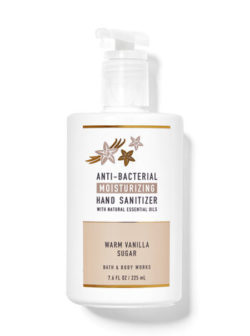
 Non-aerosols disperse less evenly, so hold the bottle a bit closer to your hands and be sure to douse all areas. One beauty editor favorite,
Non-aerosols disperse less evenly, so hold the bottle a bit closer to your hands and be sure to douse all areas. One beauty editor favorite, 